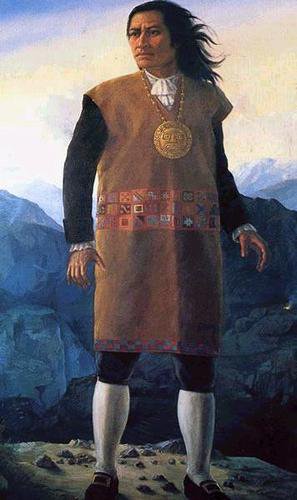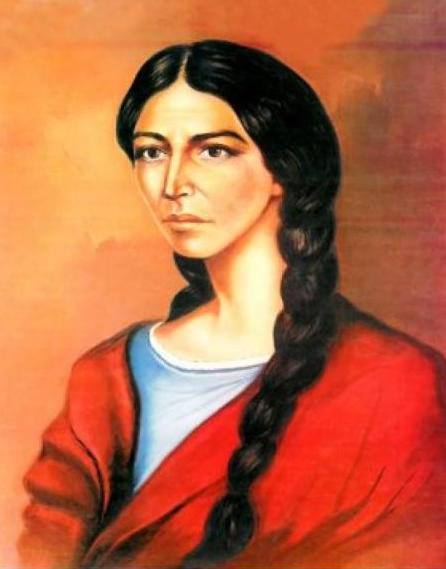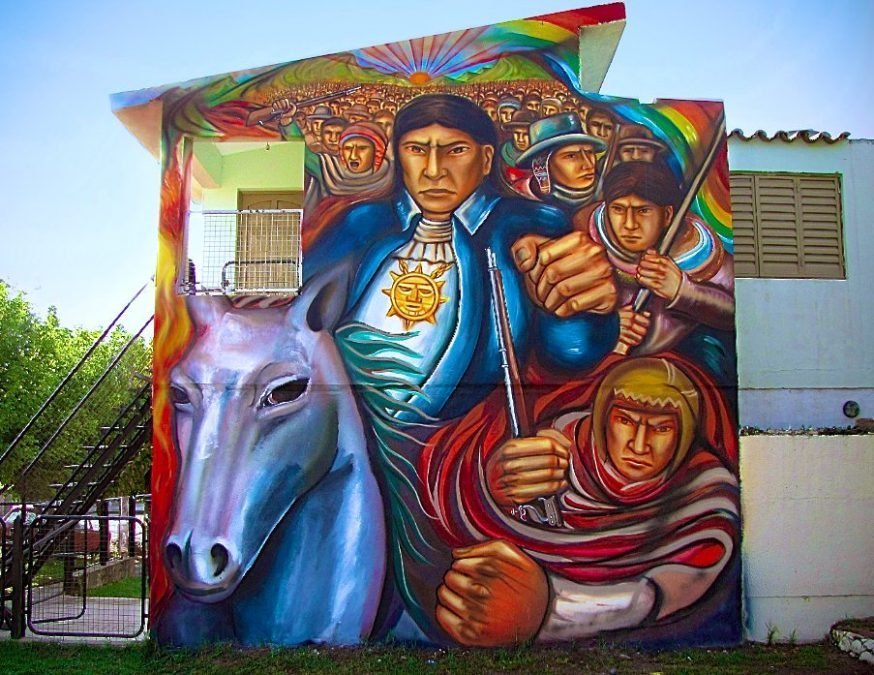From Jacobin
Tension spread throughout the Andes in the eighteenth century. Colonial authorities increased taxes, demanded more free labor from rural people, and chipped away at indigenous communities’ autonomy. Dozens of revolts erupted. None, however, approached the scale, violence, or impact of the Túpac Amaru rebellion, which took place between 1780 and 1783.
On November 4, 1780, José Gabriel Condorcanqui Noguera, who increasingly used his Inca royal name Túpac Amaru, had lunch with Antonio Arriaga, a local Spanish authority. They met in Yanaoca, a largely indigenous (Quechua) town fifty miles south of Cusco, the ancient capital of the Incas. Túpac Amaru was the kuraka or cacique, the ethnic authority in charge of collecting the head tax and keeping order in three nearby towns. As corregidor, Arriaga collected tax revenues, organized the hated Potosí labor draft (mita), and oversaw the region. The two men knew each other well, and even if they discussed debts and other disagreeable topics, they probably shared a nice meal and conversation. They began the journey home together, but Túpac Amaru split off along the way.
Túpac Amaru and his allies rushed ahead to a hiding place in Arriaga’s route. They leaped into the corregidor’s path and, after much confusion and an escape attempt, took them in chains to Tungasuca. Túpac Amaru forced Arriaga to request money and weapons from his treasurer and expropriated muskets, bullets, gunpowder, gold, silver, mules, and other goods. Túpac Amaru invited regional property owners and military figures to Tungasuca and instructed kurakas to send their Indians.
By November 9, large crowds had congregated in Tungasuca. Túpac Amaru and his deputies had imprisoned some of the Spaniards but instructed Europeans, mestizos, and Indians to line up in a military column. He was dressed elegantly, combining velvety European fashion with Inca flourishes such as the tunic, an uncu, and a gold chain with the Inca sun or inti. The following day, he congregated the crowd again, estimated in the thousands.
In these days of high drama when no one was quite certain what was happening, Túpac Amaru’s wife, Micaela Bastidas, accompanied him. Many noted that they made decisions together. In a choreographed performance, Túpac Amaru and his retinue brought Arriaga to hastily created gallows. Túpac Amaru claimed that the king had abolished the alcabala or sales tax and accused Arriaga of unjustly enforcing this and other despised taxes and demands on indigenous people. He repeatedly said he was acting in the name of the king and abolished not only the sales tax but also custom houses, the forced sale of goods (reparto), and the mita. He spoke in Quechua, the language of the Incas and that of the vast majority of the region’s inhabitants. Executioners forced Arriaga to change from his military uniform into a simple Franciscan habit. Arriaga’s own black slave, Antonio Oblitas, carried out the hanging. The flabbergasted crowd witnessed an indigenous authority execute a Spaniard and promise a more just world.
The Túpac Amaru rebellion had begun.

The Road to Cusco
Túpac Amaru took his rapidly assembled troops to the south. They ransacked estates and textile mills or obrajes (often used as prisons), chased Spanish authorities, and recruited soldiers. Túpac Amaru gave stump speeches in plazas, urging all to join him to fight the injustices imposed by corregidors. His ideology combined Inca revivalism with various strains of contestatory Spanish traditions. He sought a multiethnic movement, inviting “good” Spaniards, creoles, mestizos, and indigenous people to join. As a devout Catholic, he was accompanied by a priest. His followers increased rapidly as he pushed toward the Lake Titicaca area. The rainy season had just begun, and indigenous peasants had several months before the cosecha or harvest. Witnesses describe the gallant Túpac Amaru and his poorly armed but highly motivated soldiers storming across the Andes.
Micaela Bastidas stayed in Tungasuca but played a fundamental role in the rebellion. She was in charge of logistics, especially organizing makeshift weapons and food. She also communicated with other towns and rebel detachments, seeking to increase the rebellion’s numbers, maintain discipline, and track what authorities were doing in Cusco. Finally, she followed her husband’s progress as he moved to the south, alerting him of a variety of dangers and the need to attack Cusco before Spanish reinforcements came from Lima or elsewhere.

Authorities in Cusco found Arriaga’s execution shocking, but understood it as a local revolt, common in the eighteenth-century Andes. They reported the event to Lima and sent the militia. The rebels, however, crushed them in the battle of Sangarará on November 18. Reports claimed five hundred died, including twenty Europeans; rebels released twenty-eight wounded Creoles, people of European descent born in the Americas. Sangarará’s majestic church caught fire, probably from royalist gunpowder. Authorities, however, blamed the rebels and began an effective campaign against them as church-burning heretics. Cusco’s bishop Juan Manuel Moscoso y Peralta excommunicated Túpac Amaru.
Heeding the recommendation of Micaela, Tupac Amaru returned to Tungasuca in mid-December. Just before the new year, tens of thousands of rebels marched toward the Inca capital. Both sides counted on spies and sentinels. Skirmishes slowed the rebels’ pace. In the final days of December, up to forty thousand rebels surrounded the city. Cusco’s inhabitants awaited an epic confrontation and perhaps a long siege. Yet the rebels hesitated. Some claim that Túpac Amaru worried that he would have to kill thousands of Indians who the Spanish had placed at the front lines. Authorities had organized the city well, and their troops harassed the rebel front lines and camp. They fought on the outskirts for over a week, and on January 10, 1781, Tupac Amaru and his troops retreated to the south.
The Execution of Túpac Amaru
Historians have long debated this failure of the rebels to take Cusco. Some have said it was Túpac Amaru’s humanitarian desire to save lives that prevented him from making the attack. Others contend that he worried that once he took the city, the rebels would be vulnerable to an attack from Lima. Perhaps he recognized that he did not have the support in the city that he expected.
Just one week after the rebel retreat, more than fifteen thousand soldiers arrived from Lima. They counted on horses, weapons, and seemingly unlimited supplies. The officers were Spaniards while most of the foot soldiers were mulattos and other members of Lima’s mixed-race lower classes. They benefitted from the support of the Chinchero kuraka, Mateo Pumacahua, who led hundreds of indigenous troops. After only a few days of rest, the royalists pursued the rebels to the south.
Túpac Amaru coordinated with his troops while Micaela oversaw the building of fortifications. The rebels used the region’s steep topography to their advantage, pushing boulders from peaks, cutting off passes, and engaging in hit-and-run attacks, scurrying up steep hills afterward. The royalists adjusted, keeping their cavalry in the valleys and using their muskets and cannons as well as indigenous soldiers strategically. Both sides claimed victory and complained that the other fled rather than engaged. The rebels struggled with internal divisions, as some criticized the failure to take Cusco. More importantly, by March rebel supporters needed to return to their homes for the busy harvest season. Hundreds if not thousands fled.
In early April, royalists lured the rebels into a trap, killing hundreds, seizing their rustic cannons, and flattening their fortifications. On April 7, they captured Bastidas, two of her sons, and other family members as they escaped to the south. They had waited for Túpac Amaru for too long. The rebel leader followed their prearranged escape plan and made it to the town of Langui. Two of his followers encouraged him to rest before continuing. He realized too late that it was a trap. They restrained him until two militia members burst in to tie him up, eager to gain the reward for his capture. A well-armed battalion marched the prisoners to Cusco. Before departing, royalists killed hundreds and perhaps thousands in the rebel’s core area.
Colonial authorities held swift trials of the prisoners. They sought information about who supported the rebellion, particularly in the cities of Cusco and Lima. The potency of the rebellion had shocked authorities. When he refused to give names, authorities tortured Túpac Amaru with the bone-breaking garrucha or pulley system. The visitador José Antonio de Areche sentenced Túpac Amaru, Micaela Bastidas, and members of their inner circle to death.
On May 18, executioners escorted the two rebel leaders, one of their sons (their thirteen-year-old son Fernando was too young for the death penalty but was forced to watch), and seven others to the gallows in Cusco’s main plaza. They hanged the men and used the garrote to asphyxiate Tomasa Tito Condemayta, a female kuraka and rebel boss. Bastidas and José Gabriel went last. Executioners slashed Bastidas’s tongue and then applied the garrote. It did not work so they strangled her with a rope. The executioners cut Túpac Amaru’s tongue and tied his limbs to four horses to be quartered. Even this did not manage to kill him so Areche ordered his beheading. Authorities displayed the group’s body parts across rebel territory.
The Rebellion Is Crushed
The Spanish believed that this grisly execution would mark the end of the rebellion and rid the Andes of Quechua, indigenous culture, and the memory of the Incas, but they were wrong on both counts. Túpac Amaru and Micaela’s oldest son, Mariano; Túpac Amaru’s cousin, Diego Cristóbal; and Andres Mendigure, a relative of Micaela, had avoided capture and led a second phase of the rebellion. They were shockingly young: eighteen, twenty-six, and seventeen respectively. They pushed the rebellion to the south, toward Lake Titicaca, and unlike Túpac Amaru, they were much more willing to attack Spaniards, Creoles, and priests. The royalists reacted with brutality, and it became a total war; no prisoners were taken and accounts of atrocities on both sides mounted in the second half of 1781 and 1782. The royalists struggled with supplies in the vast plateau and mountain peaks of the southern Andes, the Lima foot soldiers miserable with the altitude (much of the fighting took place above four thousand meters), cold, and hunger.
The Túpac Amaru rebels coordinated with the Katarista insurgents who controlled much of Charcas, which is what later became Bolivia. They shared information with Túpac Katari, who organized the grueling siege of La Paz. He had taken this name to honor Túpac Amaru and the Katari brothers who had initiated the rebellion. By late 1781, royalists looked with anguish as rebels controlled much of the territory stretching from the mines of Potosí to Cusco. The rebellion had entered its most violent and powerful phase.
The Spanish were divided and fought about how to proceed. Moderate leaders recognized their poor prospects and sought to negotiate with the rebels. Hard-liners fumed and wanted a military victory. In the end, the moderates prevailed and opened lines of communication. The exhausted rebel leaders remembered too well the fate of Túpac Amaru and Micaela Bastidas and also realized that continued warfare would provoke famine in the highlands. They accepted a ceasefire; the second phase came to an end thanks to negotiations rather than battle.
In the following months, however, the hard-liners among the royalists plotted to break the truce, accusing the rebel leaders of continuing their struggle. In February 1783, authorities arrested the three young leaders and other participants on trumped-up charges of subversion. After a trial that again sought to unmask the rebellion’s followers, Diego Cristóbal and the two other leaders were executed in an even bloodier fashion than the events of May 18, 1781. Executioners used burning pincers to rip the skin off of Diego Cristóbal and then hanged him. Local authorities once again displayed body parts across the region. The rebellion was over. Up to one hundred thousand had died.
A Memory of Resistance
The Spanish sought to stifle the memory of the rebellion and to prevent it from converting into a symbol of resistance. They succeeded in the short term. Unlike the Haitian Revolution, the story of Túpac Amaru didn’t become a story across the Atlantic. For one, the Andean rebels had lost, and they had threatened neither the sugar nor the slave economy. Nonetheless, the name Túpac Amaru appeared in curious places. In Haiti itself, General Jean-Jacques Dessalines called his rebel forces “The Army of the Incas” and during the wars of independence patriot forces in what became Uruguay took the name Tupamaros. In the early nineteenth century, authors began to write about the rebellion. Río de la Plata, what became Argentina, considered naming Juan Bautista Tupac Amaru — the rebel leader’s half-brother who spent more than thirty years imprisoned in Ceuta — as king. Leaders of the patriot forces in Peru’s wars of independence, however, did not invoke the rebellion, and Túpac Amaru did not become a hero in the nascent republic.

It was in the nineteenth and twentieth centuries that interest in the rebellion really grew, as Túpac Amaru became a left-wing symbol. Nonetheless, he was never a national hero, and his story was largely excluded from Peruvian textbooks.
It was not until Peru’s left-leaning president Juan Velasco Alvarado came to power in 1968 that Túpac Amaru was rescued from relative oblivion. Just as Fidel Castro stressed that the Cuban Revolution would finish the War of 1898, Velasco promised that his government would give peasants (the term used in the period) the dignity and opportunities promised by Túpac Amaru. The rebel leader’s image, refashioned by talented artists, appeared on banners, posters, bills, coins, stamps, and publications. Micaela, his wife, however, did not play such a prominent role. In fact, she continued to be falsely presented as slim and white, not the Andean woman (perhaps with Afro-Peruvian lineage) that she was.
Since then, Tupac Amaru’s fame has grown. A Uruguayan guerrilla group adopted his name, the Tupamaros. They would not be the last guerrilleros to do so. Soon, the name Túpac Amaru had global significance. In 1972, Afeni Shakur, a member of the Black Panthers, changed her infant son’s name from Lesane Parish Crooks to Tupac Amaru Shakur in honor of the Peruvian revolutionary.
“I Will Be Millions”
In the half-century since the Velasco regime, Túpac Amaru has blossomed as a symbol or icon in Peru and beyond. We have many Tupacs: most commonly the muscular, ponytailed revolutionary popularized in the twentieth century but also artistic renditions that range from the hyper-radical to a lipsticked feminized Tupac. Disliking the notion of an Andean revolutionary hero (they prefer them of European-descent and moderate), conservatives have begun to question Túpac Amaru’s legitimacy and relevance. They claim that he was actually a member of the elite or that he rose up merely out of self-interest.
Túpac Amaru and Micaela Bastidas have now become potent symbols for Andean people. Their images grace banners and posters in a variety of political movements, from northern Argentina and Chile to Ecuador, and throughout Peru. Organizations demanding equal rights for Quechua people, mobilizing against mines that damage indigenous communities, and questioning colonial practices almost invariably invoke the two revolutionary leaders. In Bolivia, the Katarista movement — in honor of Tupac Katari, himself named after Túpac Amaru — bolstered Luis Arce’s crushing victory on October 18, 2020, heralding a return to democracy. It is safe to say that efforts by the Spanish and others to erase the memory of the Túpac Amaru rebellion have failed.
Leave a Reply
You must be logged in to post a comment.